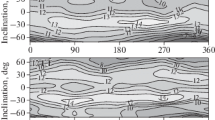Abstract
The principal diurnal anomalies in the maximum electron density of ionospheric F2 layer over Kodaikanal are discussed. From an analysis of data obtained over half a solar cycle, it has been found that the phenomena of rapid increase in the electron densities following sunrise, the diurnal asymmetry and the maintenance of abnormally high ionic densities after sunset undergo systematic changes during stormy conditions. In order to examine whether these changes are accounted for by additional movements during disturbed conditions, magnitudes of movement terms of the continuity equation at three heights, for the quiet as well as the disturbed days, have been computed and discussed. The changes in the pattern of diurnal variation of N m F2 with solar activity and the mechanism responsible for these changes are also discussed. From an analysis of published F2 layer data obtained at a number of stations with magnetic dip between ± 40°, it has been shown that the ratio of morning to afternoon peak densities yields a fair measure of equatorial F2 layer distortion anomaly. From solar cycle variation in diurnal asymmetry, an attempt has been made to estimate the extent by which the anomalous belt widens during sunspot maximum.
Similar content being viewed by others
10. References
Appleton, E. V. and Piggott, W. R.J. Atmosph. Terr. Phys., 1952,2, 236.
Applaton, E. V. .. “Some ionospheric results obtained during the I.G.Y.”,Proceedings of the Symposipm Organised by the URSI/AGI Committee, Brussels, (1959), Edited by W. J. G. Beynon, 1960, p. 4.
Berkner, L. V. and Seaton, S. L.Terr. Mag. and Atmos. Elec., 1940,45, 419.
Egedal, J... ——Ibid., 1947,52, 449.
Ferraro, V. C. A... ——Ibid., 1945,50, 215.
Hirono, M. and Maeda, H.J. Geomagn. Geoelectt 1954,6, 127.
Martyn, D. F...Proc. Roy. Soc., 1953,218 A, 1.
—————..Report of Conference on Physics of the Ionosphere, Physical Society, London, 1954, 257.
Matsushita, S. ..Proceedings of Mixed Commission on the Ionosphere, Third Meeting (Canberra), 1952, p. 124.
Ratcliffe, J. A., Schmerling, E. R., Setty, C. S. G. K. and Thomas, J. O.Phil. Trans., 1956,248 A, 621.
Skinner, N. J. and Wright, R. W.J. Atmosph. Terr. Phys., 1955,6, 177.
Schmerling, E. R. and Ventrice, C. A. ——Ibid., 1959,14, 249.
Author information
Authors and Affiliations
Additional information
Communicated by Dr. M. K. Vainu Bappu,f.a.sc.
Rights and permissions
About this article
Cite this article
Bhargava, B.N., Subrahmanyan, R.V. The influence of disturbed conditions and increased solar activity on geomagnetic distortion of the equatorial ionospheric F2 region. Proc. Indian Acad. Sci. 55, 330–344 (1962). https://doi.org/10.1007/BF03045810
Received:
Issue Date:
DOI: https://doi.org/10.1007/BF03045810




